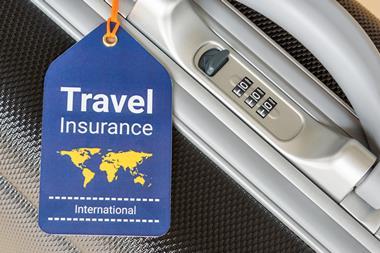Insurance Times reviews the current landscape in the travel insurance sector following the tumultuous years of the Covid-19 pandemic
According to independent international organisation The World Economic Forum, travel and tourism is expected to fully regain its popularity following the lows of Covid-19 pandemic restrictions imposed from 2020.

In an article sharing the findings of its Travel and Tourism Development Index 2024, published in May 2024, the organisation said: “International tourist arrivals and the travel and tourism sector’s contribution to global [gross domestic product] are expected to return to pre-pandemic levels this year, driven by the lifting of Covid-19-related travel restrictions and strong pent-up demand.”
Francisco Betti, head of the global industries team at The World Economic Forum, added: “This year marks a turning point for the travel and tourism sector, which we know has the capacity to unlock growth and serve communities through economic and social transformation.”
Although the travel sector has seemingly moved past the shock of the global health crisis, it continues to deal with macroeconomic, geopolitical and environmental risks – including, for example, global conflicts.
In addition, labour shortages are ongoing and – worsened by global inflation – have increased both prices and service issues.
Against this backdrop, what is the current lay of the land in the travel insurance market and how is this product evolving?
Steve Parker, product development director at Staysure Group, told Insurance Times: “As Covid-19 disrupted travel plans worldwide, take up of travel insurance dropped. However, travellers began prioritising insurance cover that specifically addressed pandemic-related concerns.
“This shift in focus prompted the travel industry to review and adapt cover to meet these new needs.”
For example, insurers began introducing additional cover options in response to the Covid-19 pandemic for customers travelling to Europe – despite the UK government’s Foreign, Commonwealth and Development Office (FCDO) advising against non-essential travel during the primary pandemic years.
Parker added: “The pandemic acted as a wake-up call for many travellers. The widespread disruptions and uncertainties emphasised the importance of having adequate insurance cover when embarking on trips.
“This heightened awareness prompted more travellers to carefully consider their insurance needs and seek out the right cover options before travelling.”
Stripped back cover
The pandemic also impacted the number of travel insurance providers and products that were available as insurers amended coverage or removed themselves from the market.
Read: FCA reveals findings of review into travel insurance signposting rules
Read: Aviva adds wellbeing services to personal accident and business travel offering
Explore more personal lines stories here, or discover more news here
Anna-Marie Duthie, insight consultant for general insurance at Defaqto, said: “Pre-pandemic, we saw the highest number of brands and products in the travel space that we had ever recorded.
“However, post-pandemic, the number of brands and products have not returned to those levels – with 2022 seeing the lowest number of brands in more than a decade and the space having 275 less products since [its] height.”
The major change to travel insurance since the onset of Covid-19 in 2020 is the inclusion of cover around pandemics – this aims to insure the consumer for medical costs and cancellation due to an outbreak.
Associated to this, there has also been a reduction in the number of insurers providing cover for winter sports and cruise trips.
Duthie continued: “We also saw a huge reduction in those offering scheduled airline and end supplier failure (SAF) [cover] due to a key provider of these elements withdrawing from the market.
“We no longer see any providers offering SAF as an optional element, with 85% no longer including cover at all, meaning consumers are having to rely on section 75 under their credit card as long as they paid for their flight and trip elements by this method.
“Only 20% [of travel insurers] now cover financial failure, so that is for things like your accommodation or transport provider going bust.”
Product evolution
According to Parker, the Covid-19 pandemic significantly impacted travel insurance rates due to several factors.
Increased risks, such as trip cancellations and Covid-19-related medical emergencies, led insurers to adjust rates to cover potential losses. Economic instability and inflation also played a role in these adjustments.
He explained: “Insurers expanded cover options to include pandemic-related risks, which further contributed to rate increases.
“Overall, travellers experienced higher premiums as insurers responded to the challenges posed by the pandemic.
“The impact on rates is gradually diminishing as we gain a better understanding of the associated risks and with this improved knowledge, we continue to more accurately assess and estimate the risks.”
Volatility in different parts of the world, along with pressures on the travel industry itself due to staff shortages, air route capacity and other sector supply factors have also impacted cover options.
Duthie said: “Another hangover from Covid has been the many disruptions travelling has seen since then and over the past year, travel disruption type covers have also seemingly been the focus for many providers.
“A key area of change has been enforced stay abroad, which has seen a huge uplift in cover availability over the last decade, with a further 22% increase in those including cover since 2018.
“This would provide cover for additional accommodation and transport costs incurred if you are unable to return home as planned due to an insured peril, such as severe weather or a natural disaster.
“We have also recorded increases in the average benefit paid for delay, currently standing at £48 for the initial period, and more products now cover missed international connections – up 14% in the last 12 months.”
Risky destinations
However, some consumer habits remain the same in 2024 as they were pre-pandemic.
James Devereux, senior propositions manager at Aviva, noted: “Although a lot has changed since the pandemic, people are still looking for quality cover and service from a reputable brand. Cost is also becoming increasingly important.
“Small, isolated events such as wildfires and strikes are also becoming more common, not to mention the impact of inflation, which has increased the cost of holidays, flights and medical bills abroad – all of which will impact travel insurance premiums.”
As the number of people travelling abroad rises, so too does the number of destinations they are heading for. However, wars, territorial disputes and geopolitical instability around the world means that travellers remain at risk from getting caught in the crossfire.
Parker said: “Destinations flagged with travel advisories or warnings by the FCDO often pose challenges to provide cover. These could include countries experiencing political unrest, civil conflict, or heightened security risks.
“Additionally, areas with significant health and safety concerns can also be challenging to cover adequately, with restrictions or limitations on cover imposed for these destinations due to the increased likelihood of travel disruptions, health emergencies, or other adverse events.
“Travellers should check FCDO advice before planning trips and review their cover carefully to understand any limitations for high risk destinations.”












































No comments yet